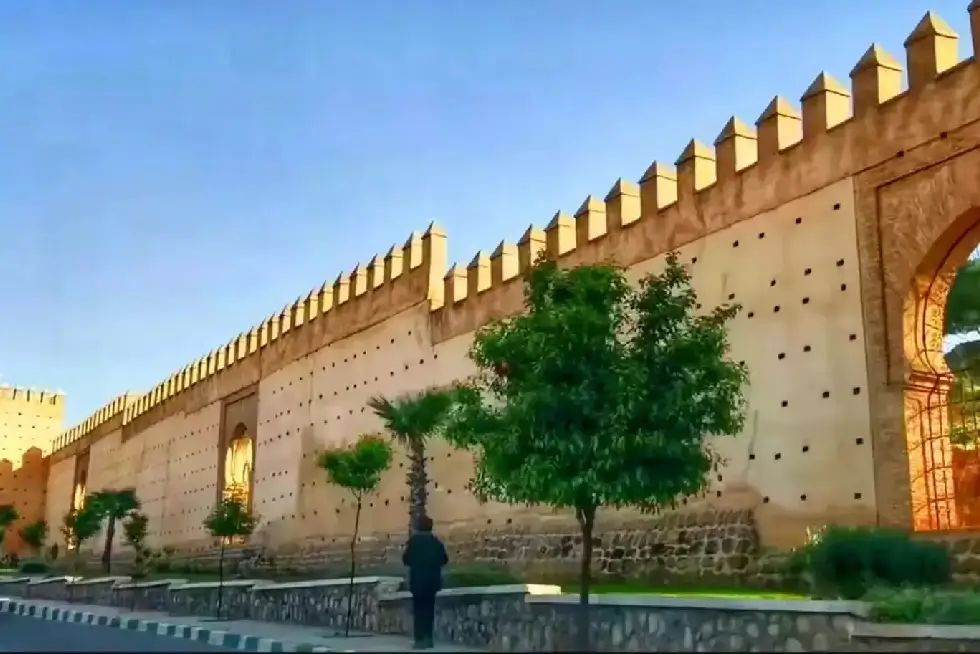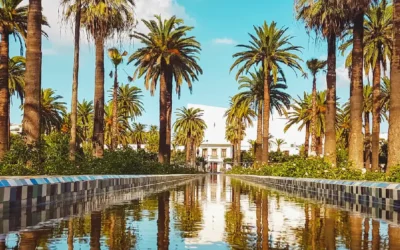Taza: The City Between The Rif And The Middle Atlas Mountains Of Morocco

Table of Contents:
Introduction To Taza City
Taza is a city in the Fès–Meknès region of northern Morocco, strategically situated between the majestic Rif and Middle Atlas mountains. It forms a crucial link, about 120 km east of Fez and 150 km south of Al Hoceima.
The name of Taza stems from the Berber word ‘Tizi’ which means ‘a hill between mountains,’ aptly mirrors its unique geographical position. The city also is the administrative heart of Taza Province.
Taza has a historical significance Tracing its roots back to its inception as Ribāt Taza, a Fatimid military camp established by Musa ibn Abi’l-Afiya. The city’s history flourished as a pivotal trading hub on the Fez-Algerian frontier route until the early 20th century.
Taza Discovery Tour
Taza presents a variety of attractions for visitors to discover. Here are some of the popular places to explore and enjoy:
1. The Great Mosque of Taza
An impressive religious site built in the 11th century, featuring a beautiful courtyard and minaret.
2. Taza National Park
Home to diverse wildlife and offers hiking, mountain biking, and camping.
3. The Souk of Taza
A vibrant market selling everything from spices to jewelry, perfect for finding unique souvenirs.
4. The Old City
Filled with ancient ruins, mosques, and palaces, including the 16th-century Taza Citadel.
5. Jardin Ibn Batouta
A serene garden offering a tranquil retreat with lush greenery and water features.
6. Local Markets
Explore handcrafted goods, textiles, ceramics, and spices, and engage with local artisans.
7. Local Restaurants in Taza
Savor traditional Moroccan cuisine like tagines, couscous, and mint tea.
8. Museum of Antiquities
Showcases artifacts and exhibits about Taza’s historical journey.
9. Jbel Tazekka Mountains
Offers stunning landscapes, hiking trails, and opportunities for outdoor activities.
10. Parc Lalla Amina
A peaceful park in the city center, ideal for relaxation and enjoying nature.
11. Day Trip to Fez City
Explore the UNESCO-listed medina, historical landmarks, and vibrant culture.
12. Tazekka National Park
A biodiverse park with lush forests, wildlife, and trekking trails.
13. Al Mansour Addahbi Mosques
A grand mosque complex with traditional Moroccan architecture.
14. Taza Medina
The old walled city features shops, traditional houses, and markets, rich in culture and history.
Taza Accessibility And Transportation
Situated in the picturesque intersection of the Rif and Middle-Atlas mountains, Taza, Morocco, is a crucial hub for regional travel. It offers various transportation options.
1. Public Transportation: Easy Access to Nearby Cities
Taza’s connectivity by road and rail is a highlight for both locals and visitors. The city is just a two-hour journey from Fez, whether by train or road. Additionally, Taza’s proximity to Meknes and Nador, each about two and a half hours away by car, adds to its accessibility.
However, for local gems like the Friouato Caves, you’ll need to opt for a grand taxi or minivan, as regular public transport doesn’t service these locations.
2. Trains and Buses: Linking Major Cities
Morocco’s train network, including a route to Taza, is a favored choice for intercity travel. Announcements in Arabic and French, along with comprehensive station information, make train travel in Morocco user-friendly.
Buses, offering varying comfort levels at reasonable prices, also crisscross the country. However, city buses might be less suitable for foreigners due to concerns about overcrowding and safety.
3. Taxis: From Petite to Grande
Taza, like other Moroccan cities, offers two kinds of taxis: the smaller, metered ‘petit taxi‘ for city travel, and the larger ‘grand taxi‘ for longer distances. The latter operates on fixed routes with negotiable fares based on distance.
4. Self-Drive: Car Rental Insights
For those valuing independence, renting a car is a viable option. Taza’s car rental services require an ID card or passport and an international payment card for security. Ensure your rental agreement includes basic insurance and accounts for the 20% tax.
5. Safety Tips for Nighttime Driving
Driving in Taza after dark demands extra caution. The legal speed limit drops to 20 km/h at night, and the risk of encountering animals or heavy trucks increases.
Given Morocco’s challenging road safety record and aggressive driving culture, vigilance is key for a safe journey.
Modern Taza and its Economic Significance
Taza, a city in Morocco, has a diverse and evolving economic landscape that reflects both its rich history and its modern aspirations.
1. Agriculture and Animal Husbandry
The Lifeline of Taza’s Economy Taza, a vibrant city in Morocco, boasts an economy deeply rooted in agriculture. The city’s favorable Mediterranean climate, situated between the Rif and Middle Atlas Mountains, fosters a flourishing agricultural scene.
Taza is renowned for its diverse crop production, including cereals, legumes, olives, and citrus fruits, which are pivotal for its economic health.
Animal husbandry is another cornerstone, with dairy, meat, and wool production being key contributors, reminiscent of a dynamic marketplace with thriving trade activities.
2. Mining and Industrial Development
A Balancing Act Mining forms a significant part of Taza’s economy, thanks to its rich mineral resources. The extraction of minerals such as lead, zinc, and barite is a major driver of industrial development and employment.
However, this sector’s rapid expansion brings to light environmental concerns, emphasizing the need for a delicate balance between economic growth and environmental preservation.
3. Cultural Heritage and Colonial Impact
Historically, Taza was a center for traditional crafts. The arrival of French colonialism in the early 20th century marked a dramatic shift, with European trade and industry reshaping the local economy.
Traditional crafts faced challenges, and some, like tanning and soap-making, declined due to competition from imported goods. This era marked a significant transition from local crafts to European-dominated industries.
4. Environmental Efforts
Taza National Park Taza is proud of the Taza National Park, a symbol of its commitment to eco-friendly economic development.
The park, with unique features like the Guerrouch area’s gall oak formations and the Kabylie nuthatch, aims to integrate economic growth with environmental conservation. It attracts researchers and students, highlighting Taza’s ecological significance.
5. Future Directions
Diversification and Challenges The future of Taza’s economy lies in diversifying beyond traditional sectors like agriculture and mining. The city is keen on expanding into tourism, education, and healthcare.
However, this transition faces hurdles in infrastructure, skill development, and investment attraction. Effective economic policies and international cooperation are essential for Taza’s journey towards a sustainable and diversified economy.
Taza History Overview
A. Taza: A Jewel of Morocco’s History
Taza’s rich past stands as a testament to the region’s colorful history.
Established by the Miknasa Berbers in the late 7th Century, Taza first allied with the Idrisids in 790. Its alliances shifted over time, first to the Fatimids of Kairouan and later to other empires.
Strategically positioned in the Taza Gap, a key route to northwestern Africa, Taza became a highly sought-after prize. The Almoravids seized it in 1074, succeeded by the Almohads in 1132, and finally, the Marinids in 1248.
B. The Medina: A Glimpse into Architectural Mastery
At the core of Taza lies its ancient town, or medina, standing proudly at 1919 feet. Initially a Fatimid military camp named ‘Ribāt Taza,’ it was later developed by the Almoravids, Almohads, and Marinids.
The medina, now a national cultural heritage site, showcases a blend of various historical architectural influences.
C. Cultural and Religious Epicenter
Beyond its political importance, Taza was a hub for culture and religion. Under Marinid rule, it became the sultans’ official summer retreat.
The city was adorned with madrasas, fonduks (hotels), baths, and a grand Great Mosque, surpassing even Fez’s mosque in grandeur.
This era marked Taza as a premier center of learning and prosperity, home to a significant Jewish population as well.
D. Taza in the Alaouite Era
Continuing its legacy, Taza shone brightly into the 18th century. Al-Sharqi Al-Ishaqi, minister to Alaouite Sultan Moulay Ismail, admired it as an impenetrable fortress and a showcase of Marinid art.
The Great Mosque, especially noted for its size, durability, and exquisite gypsum art, stood as a highlight.
E. Transition to Modernity: The French Conquest
Despite its formidable past, Taza fell to French colonial forces in 1914, ushering in a new era. The French established a modern town in 1920 on a nearby fertile plain, starkly contrasting the ancient medina’s elevated position.
This period marked significant transformations in Taza’s urban and cultural landscapes.
Conclusion
Taza, This Moroccan city, cradled between two majestic mountain ranges, is a vibrant blend of ancient charm and bustling life.
The city is more than just a geographical bridge between regions, is a living symbol of Morocco’s heritage. It invites us to carry its stories in our hearts and beckons us to return.
FAQ
What is the origin of Taza’s name?
The name “Taza” comes from the Berber word ‘Tizi’, meaning a hill between mountains,’ which perfectly describes its unique geographical position.
What is the historical significance of Taza?
Established by the Miknasa Berbers in the 7th Century, Taza has been an important political, cultural, and religious center under various dynasties. Its Medina is a testament to its rich history.
What is the geographical significance of Taza?
Taza is strategically located between the Rif and Middle Atlas mountains in northern Morocco. It serves as an important link between Fez and Al Hoceima, reflecting its historical role as a pivotal trading hub.
What are some must-visit attractions in Taza?
Visitors should not miss the Great Mosque of Taza, Taza National Park, the vibrant Souk of Taza, historical ruins in the Old City, Jardin Ibn Batouta, local markets, traditional restaurants, Museum of Antiquities, Jbel Tazekka Mountains, Parc Lalla Amina, a day trip to Fez City, Tazekka National Park, Al Mansour Addahbi Mosques, and the Taza Medina.
How accessible is Taza, and what are the transportation options?
Taza is accessible by road and rail, with a two-hour journey from Fez. Options include public transport, trains, buses, petite and grande taxis, and car rentals. Nighttime driving requires caution due to a lowered speed limit and increased risks.
What is the economic base of Taza?
Taza’s economy is primarily based on agriculture and animal husbandry, mining, and traditional crafts. The city is exploring diversification into tourism, education, and healthcare.
What are the environmental efforts undertaken by Taza?
Taza National Park symbolizes the city’s commitment to eco-friendly development, preserving unique flora and fauna, and promoting ecological research and education.
How has Taza’s economy evolved?
The economy of Taza has transitioned from traditional crafts to a more European-dominated industry due to French colonialism. The city is now focusing on economic diversification and sustainable development.
What are some cultural highlights of Taza?
Taza’s Medina, rich in architectural mastery, and its role as a cultural and religious epicenter under various dynasties, are key cultural highlights. The city has been home to significant madrasas, baths, and mosques.
What was the impact of the French conquest on Taza?
The French conquest in 1914 led to significant urban and cultural transformations in Taza. A modern town was established in 1920, marking a stark contrast to the ancient medina.
What are some safety tips for visitors in Taza?
Visitors are advised to exercise caution while using public transport due to concerns of overcrowding. Nighttime driving demands extra vigilance, and it’s recommended to be aware of Morocco’s driving culture for safety.
Are there any specific local dishes or restaurants in Taza that visitors should try?
Traditional Moroccan cuisine like tagines, couscous, and mint tea are highly recommended. Visitors should explore local restaurants in Taza for an authentic culinary experience.



